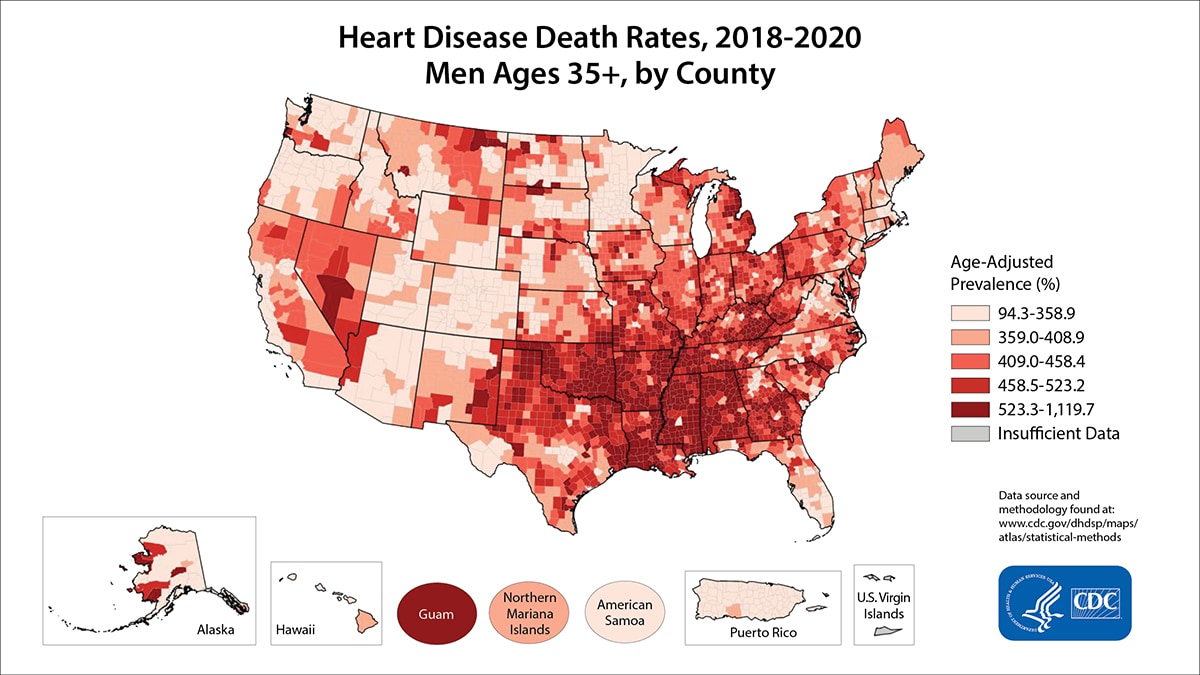Key points
- The term heart disease refers to several types of heart conditions.
- Heart disease is the leading cause of death for men in the United States.

Overview
The term heart disease refers to several types of heart conditions, including coronary artery disease and heart attack.
Heart disease is the leading cause of death for men in the United States.1

Symptoms
Sometimes heart disease may be "silent" and not diagnosed until a man experiences signs or symptoms of a heart attack, an arrhythmia, or heart failure.2 Symptoms may include the following:
- Heart attack: Chest pain or discomfort, upper back or neck pain, indigestion, heartburn, nausea or vomiting, extreme fatigue, upper body discomfort, dizziness, and shortness of breath.2
- Arrhythmia: Fluttering feelings in the chest as the heart beats too slowly, too fast, or in an irregular way. A common example is atrial fibrillation.2
- Heart failure: Shortness of breath, fatigue, or swelling of the feet, ankles, legs, abdomen, or neck veins.2
Even if you have no symptoms, you may still be at risk for heart disease.
Risk factors
In 2017-2020, 50.6% of men had high blood pressure, a major risk factor for heart disease and stroke.3
Several other medical conditions and lifestyle choices can also put people at a higher risk for heart disease, including:
- Diabetes
- Overweight and obesity
- Unhealthy diet
- Physical inactivity
- Excessive alcohol use
Reducing risk
To reduce your chances of getting heart disease, it's important to do the following:4
- Know your blood pressure. Having uncontrolled blood pressure can result in heart disease. High blood pressure has no symptoms so it's important to have your blood pressure checked regularly. Learn more about high blood pressure.
- Talk to your health care provider about whether you should be tested for diabetes. Having diabetes raises your risk of heart disease.5
- Quit smoking. If you don't smoke, don't start. If you do smoke, learn ways to quit.
- Discuss checking your cholesterol and triglyceride levels with your health care provider. Learn more about cholesterol.
- Make healthy food. Having overweight or obesity raises your risk of heart disease. Learn more about overweight and obesity.
- Limit alcohol intake to one drink a day. Learn more about alcohol.
- Lower your stress level and find healthy ways to cope with stress.
- National Center for Health Statistics. Multiple Cause of Death 2018–2021 on CDC WONDER Database. Accessed February 2, 2023. https://wonder.cdc.gov/mcd.html
- National Heart, Lung, and Blood Institute. What is coronary heart disease? Accessed October 2, 2018. https://www.nhlbi.nih.gov/health/coronary-heart-disease
- Centers for Disease Control and Prevention. Hypertension Cascade: Hypertension Prevalence, Treatment and Control Estimates Among US Adults Aged 18 Years and Older Applying the Criteria From the American College of Cardiology and American Heart Association's 2017 Hypertension Guideline - NHANES 2017-2020. 2023. Accessed May 3, 2024. https://millionhearts.hhs.gov/data-reports/hypertension-prevalence.html
- Centers for Disease Control and Prevention, Million Hearts®. Prevention. Accessed October 2, 2018. https://millionhearts.hhs.gov/learn-prevent/prevention.html
- National Institute of Diabetes and Digestive and Kidney Diseases. Diabetes, Heart Disease, & Stroke. Accessed October 2, 2018. https://www.niddk.nih.gov/health-information/diabetes/overview/preventing-problems/heart-disease-stroke
- Heron M. Deaths: leading causes for 2016. Natl Vital Stat Rep. 2018;67(6):1–77.
- Benjamin EJ, Virani SS, Callaway CW, et al. Heart disease and stroke statistics—2018 update: a report from the American Heart Association. Circulation. 2018;137(12):e67–e492.
- Roger VL, Go AS, Lloyd-Jones DM, et al. Heart disease and stroke statistics—2012 update: a report from the American Heart Association. Circulation. 2012;125(1):e2–e220.
- National Heart, Lung, and Blood Institute. Stroke. Accessed October 2, 2018. https://www.nhlbi.nih.gov/health/stroke
